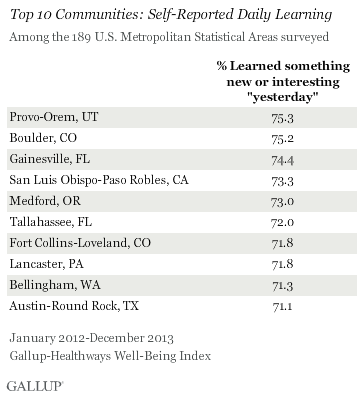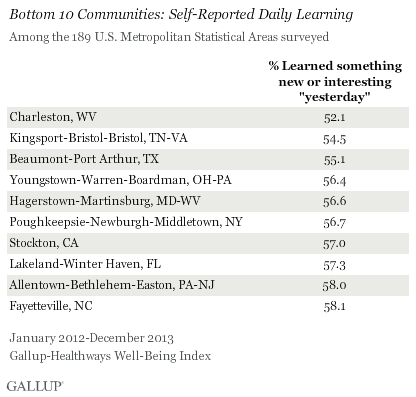Provo and Boulder Residents Report Highest Daily Learning
Reposted with permission from Gallup
WASHINGTON, D.C. — Residents of Provo-Orem, Utah, and Boulder, Colo., are the most likely to report that they learned something new or interesting “yesterday.” Provo-Orem has been among the top three cities for daily learning since Gallup and Sharecare began tracking the measure in 2008, while Boulder has consistently ranked in the top 10. Provo-Orem and Boulder are home to large colleges and universities, as are many of the communities with high levels of daily learning.
Residents of Charleston, W.Va., are the least likely to report learning something new or interesting “yesterday,” followed by those living in Kingsport-Bristol-Bristol, Tenn.-Va., and Beaumont-Port Arthur, Texas. Charleston and Kingsport-Bristol-Bristol have been among the 10 lowest-ranking communities for self-reported daily learning every year since 2008. Few communities with the lowest levels of learning “yesterday” have large college student populations. Results for all 189 U.S. Metropolitan Statistical Areas can be found on page 2.
There is a clear connection between large college and university student populations and respondent reports of daily learning. University towns often provide learning opportunities for non-students, such as symposiums, lectures, museums, and active cultural organizations.
In general, Gallup research shows that high levels of learning “yesterday” are one of the factors that set apart communities with high well-being from those with low well-being. University towns have previously been among those with high levels of general well-being. Provo-Orem and Boulder were among the communities with the five highest Well-Being Index scores in 2012-2013, while Charleston, W.Va. was among the lowest. Many communities with higher percentages of residents who are satisfied with their city or area are also locations where residents report learning something new or interesting each day.
Nationally, 63.3% of Americans learned something new or interesting “yesterday.” This is little changed from the 63.1% in 2011. Gallup and Sharecare ask Americans if they “learned something new or interesting” the day prior to the interview as part of the Gallup-Sharecare Well-Being Index. Gallup interviewed at least 300 adults aged 18 and older in 189 metropolitan areas throughout 2012-2013. Each sample was weighted to match the demographic characteristics of that area.
Among large U.S. communities — those with populations of at least 1 million — residents are slightly more likely to say they learned something than in communities with smaller populations. An average 64.5% of residents in large communities say they learned something “yesterday,” compared with 63.3% nationally. This could be because the largest communities are often home to large universities, colleges, museums, and other cultural activities that encourage residents’ daily learning. Or it could simply reflect the interests, backgrounds, and demographic characteristics of the people who choose to live in big cities as opposed to smaller communities.
Implications
In all communities, the majority of residents say they learned something new or interesting the day prior to being interviewed. However there is significant variation between the communities with the highest and lowest rates of reported daily learning. In the communities with the highest rates, like Provo-Orem and Boulder, three in four people learned something “yesterday.” In communities with the lowest learning, like Charleston, W.Va., this drops to just over half of the residents.
Many cities with higher self-reported daily learning levels are also home to large colleges and universities, while communities with lower daily learning generally have much smaller student populations. Provo-Orem, for example, is home to Brigham Young University, while Boulder is home to the University of Colorado Boulder, both of which have more than 25,000 students enrolled. Charleston, W.Va., however, has a much smaller university population. The large student populations in some communities probably drive community daily learning rates up overall, but there are also likely more learning opportunities for non-students in these areas than in non-university communities.
High learning levels correspond with overall well-being, as communities with high levels of learning each day are generally among those with the highest well-being, and communities with low levels of daily learning generally have lower well-being scores.
Explore and compare well-being data by metro area using Gallup’s U.S. Community Well-Being Tracking Interactive.
SURVEY METHODS
Results are based on telephone interviews conducted as part of the Gallup-Sharecare Well-Being Index survey Jan. 2-Dec. 29, 2012, and Jan. 2-Dec. 30, 2013, with a random sample of 531,630 adults, aged 18 and older, living in metropolitan areas in the 50 U.S. states and the District of Columbia, selected using random-digit-dial sampling. Two years of data were aggregated together to enable the same number of reportable cities as in prior years, when the overall annual data collection exceeded 350,000 interviews per year compared with 178,072 interviews conducted in 2013. At least 300 cases are required per metro area for reporting.
The metro areas referenced in this article are based on the Metropolitan Statistical Areas (MSAs) as defined by the U.S. Office of Management and Budget. In many cases, more than one city is included in the same MSA. The San Jose, Calif., metropolitan statistical area, for example, also includes the smaller nearby cities of Sunnyvale and Santa Clara in addition to San Jose itself. Each respondent is attributed to his or her MSA based on the self-report of his or her ZIP code, and all metro areas had at least 300 completed surveys in the 2012-2013 data collection period.
Maximum expected error ranges for the Well-Being Index and the sub-index scores vary according to MSA size, ranging from less than ±1 percentage point for the largest cities represented to ±1.5 percentage points for the smallest cities.
Interviews are conducted with respondents on landline telephones and cellular phones, with interviews conducted in Spanish for respondents who are primarily Spanish-speaking. Each sample of national adults includes a minimum quota of 50% cellphone respondents and 50% landline respondents, with additional minimum quotas by time zone within region. Landline and cellular telephone numbers are selected using random-digit-dial methods. Landline respondents are chosen at random within each household on the basis of which member had the most recent birthday.
Samples are weighted to correct for unequal selection probability, nonresponse, and double coverage of landline and cell users in the two sampling frames. They are also weighted to match the national demographics of gender, age, race, Hispanic ethnicity, education, region, population density, and phone status (cellphone only/landline only/both, and cellphone mostly). Demographic weighting targets are based on the most recent Current Population Survey figures for the aged 18 and older U.S. population. Phone status targets are based on the most recent National Health Interview Survey. Population density targets are based on the most recent U.S. census. All reported margins of sampling error include the computed design effects for weighting.
In addition to sampling error, question wording and practical difficulties in conducting surveys can introduce error or bias into the findings of public opinion polls.
For more details on Gallup’s polling methodology, visit www.gallup.com.


